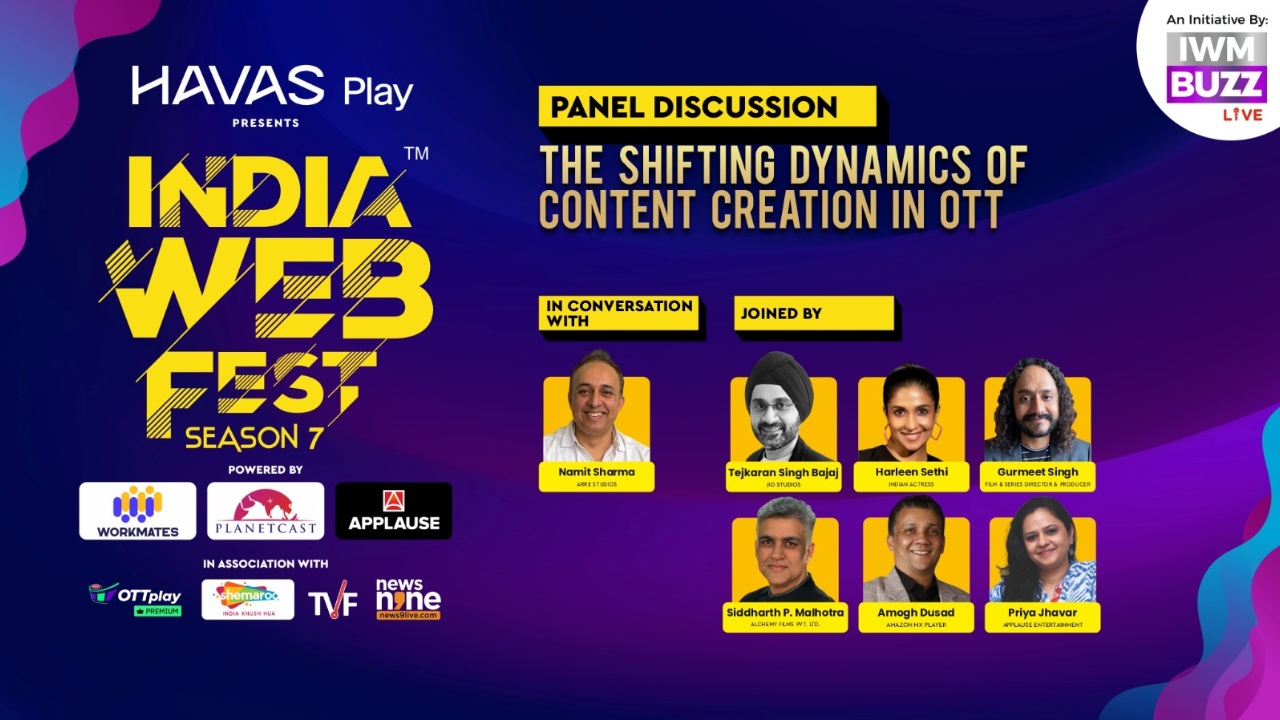There are too many stories today, and not enough time to care about most of them. That’s the quiet crisis everyone in content creation feels but rarely says aloud. At a recent panel moderated by Namit Sharma of Arre Studios, this discomfort was named, examined, and turned inside out.
This wasn’t another industry pat-on-the-back session. What they discussed wasn’t so much what’s trending, but what’s still worth doing in a space that changes by the week.
In conversation with Namit Sharma of Arre Studios, the panel featured voices across the spectrum of Indian content. Joining him were Tejkarran Singh Bajaj (Jio Studios), Harleen Sethi, Gurmeet Singh, Siddharth P. Malhotra (Alchemy Films), Amogh Dusad (Amazon MX Player), and Priya Jhavar (Applause Entertainment).
The Idea Still Matters. Maybe More Than Ever.
For all the formats, platforms, and production tools, everyone came back to the same place: without a strong idea, none of it sticks. Audiences may be swiping faster and watching smaller, but their expectation of connection, of honesty, has only grown sharper. If anything, the explosion of content has made the average viewer harder to win over, not easier.
The industry is learning that lesson in real time. It’s not about chasing trends. It’s about finding the one idea that can hold someone still for five minutes—or five episodes.
We’re Not Competing With Other Shows Anymore
One panellist put it plainly. The competition isn’t another series or film. It’s everything: reels, memes, podcasts, AI videos, notifications. That’s the landscape. Content now lives on the same screen as distractions.
So the question becomes: how do you make something that earns attention, not just demands it?
For some, the answer is in the format—quick-hit micro dramas, tight, self-contained stories built for mobile. For others, it’s about building deeper worlds that evolve over the years. But the goal is the same: make something worth coming back to.
Shorter Doesn’t Mean Shallower
Another speaker made a smart point—format follows context. People aren’t necessarily losing patience. They’re just watching differently. In queues. In transit. Between tasks. Storytelling has moved from the living room to the back pocket. So of course form evolves. Of course, snackable content rises.
But the best short-form content isn’t lesser. It’s just leaner. It’s still storytelling, just with tighter margins for error.
The Algorithm Will Never Write a Great Story
One of the more honest moments came from a producer who spoke about the push-and-pull between data and instinct. It’s no secret that platforms live by algorithms now. Content gets commissioned based on what has worked, what could work, what should work.
But there’s a quiet toll that takes on creativity. When a show is greenlit to chase a chart instead of say something new, something gets lost. It’s the creator’s job to protect that voice, even inside a system that often mistrusts it.
Big Stories Take Big Teams
One of the panellists shared what that looks like firsthand. Delivering a large-scale series meant more than ambition. It meant coordination, research, and constant compromise. There’s nothing solo about that kind of storytelling. It’s all collaboration, revision, and resilience.
The series isn’t just a creative act. It’s a logistical marathon. And that kind of work doesn’t show up in press releases or trailer drops. But it’s where the real work happens.
Experience Doesn’t Guarantee Relevance
Another voice brought a different kind of realism to the room. Being around a long time doesn’t mean you’re built for what’s next. The industry has never changed this quickly—formats, tech, audience habits, even the definition of “content” itself.
So veterans are learning to walk into unfamiliar territory with less ego and more openness. You can’t bring old assumptions into a new space and expect it to work.
The Actor’s Dilemma: Visibility vs. Craft
An actor on the panel spoke to a different pressure—what it means to be visible in the age of social media. Followers can sometimes count more than performances. Everyone’s a brand, whether they want to be or not.
But that’s not the whole story. For actors who take the craft seriously, the goal isn’t virality. It’s depth. The job is still about disappearing into characters, not marketing personas. The tension between the two is real. And constant.
Franchises Offer Familiar Ground in a Noisy Market
While much of the conversation focused on change, returning series still have a unique value. Some shows don’t just get watched—they get lived in. They give audiences something to anchor to in a feed full of novelty.
They also give creators the chance to deepen narratives rather than restart from scratch every time. That’s rare, and it’s powerful.
New Voices Aren’t Waiting for Permission
The most hopeful thread came from the rise of young, tech-enabled creators. The old model—waiting to be discovered and then greenlit—is fading. With digital tools, anyone can create something and share it with the world.
That shift is rewriting the rules of entry. Gatekeepers still exist, but their power is diluted. What matters now is voice, originality, and the willingness to start without a blueprint.
Audience Fatigue is Real. So Is the Opportunity to Surprise.
No one pretended that the audience is endlessly patient. Genres are getting stale. Crime, relationship drama, even regional stories—they’re starting to feel interchangeable when done without risk.
The panel didn’t frame this as a problem to solve, but as a chance to reset. Audiences are ready for something new. The question is: who’s brave enough to give it to them?
Final Thought: The Idea Is Still the Point
Strip away the platforms, the formats, the data dashboards, and what’s left is the same thing that’s always mattered: a story that means something. A voice that feels alive. A creator who cares about the person on the other end.
Everything else is delivery. And in an ecosystem that’s evolving faster than ever, that clarity is a kind of compass.
Tell something true. And tell it well. That’s the job. Still.

